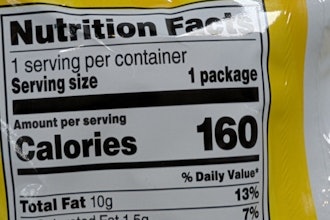
WASHINGTON — The U.S. Food and Drug Administration issued draft guidance that provides food manufacturers with recommendations on how and when to use Dietary Guidance Statements on the label of food products to ensure the label statements promote good nutrition, provide greater consistency in labeling, and assist consumers in making informed choices.
This guidance is part of the FDA’s overall goal to help reduce the burden of chronic disease and advance health equity through improved nutrition.
“Diet-related chronic diseases, are the leading causes of death and disability in the U.S. and disproportionally impact communities of color and people living in rural areas,” said FDA Commissioner Robert M. Califf, M.D. “The FDA is committed to being a part of the solution to improve the health of millions of Americans. Today’s action is another step towards helping consumers make informed choices about the foods they eat.”
Today’s eating patterns in the U.S. do not align with current federal dietary recommendations, which focus on the entirety of the diet and how foods and beverages work together to affect health. Dietary Guidance Statements are statements in food labeling which are based on key recommendations from consensus reports, such as the Dietary Guidelines for Americans, 2020-2025, that discuss how a food or food group can be a part of a nutritious dietary pattern. The statements may include symbols or pictures that convey to consumers that a food or a food group may contribute to, or help maintain, a nutritious dietary pattern.
Examples of Dietary Guidance Statements include: “Make half your grains whole grain,” and “Eat leafy green vegetables as part of a nutritious dietary patten.” The draft guidance provides the agency’s thinking about the use of such statements, including recommendations that products contain a meaningful amount of the food, or category of foods, that is the subject of the statement, and that they also not exceed certain amounts of saturated fat, sodium and added sugars. The recommendations in the guidance can enhance consistency in the use of such statements and consumer understanding as well as facilitate industry innovation toward healthier foods. Like other labeling statements and claims, Dietary Guidance Statements act as quick signals on food packages to help consumers better understand nutrition information and make healthier food choices.
Today’s action is part of the FDA’s overall nutrition initiatives, which include empowering consumers by providing more informative labeling and education, including tailored messages for various audiences to help consumers identify foods that can contribute to healthier diets. It is also part of the Biden-Harris Administration’s National Strategy on Hunger, Nutrition, and Health, which provides a roadmap of actions the federal government will take to end hunger and reduce diet-related diseases by 2030 – all while reducing disparities. Complementing today’s guidance and the National Strategy, the FDA issued a proposed rule in September 2022 to update the definition of “healthy” on food labels and help consumers more easily identify healthy food choices. The agency’s work also supports the Biden-Harris Administration’s White House Challenge to End Hunger and Build Healthy Communities, a nationwide call-to-action to stakeholders across all of society to make bold commitments to advance the Strategy’s goals. The
Challenge builds on the success of the $8 billion package of private and public sector commitments that the Administration announced as part of the historic conference.
Another priority of the FDA’s nutrition efforts is to create a healthier food supply for all. In October 2021, the FDA issued final guidance for the food industry that provided voluntary, short-term sodium reduction targets for a broad range of processed, packaged and prepared foods to help reduce the amount of sodium in the U.S. food supply.
“In addition to the Dietary Guidance Statements draft guidance, reducing sodium intake and updating the definition of “healthy” are two other examples of how the agency is showing its commitment to fostering a healthier food supply for all and empowering consumers with more informative and accessible labeling to choose healthier diets,” said Susan Mayne, Ph.D., director of the FDA’s Center for Food Safety and Applied Nutrition. “We are making great strides in our nutrition initiatives in order to improve the health and wellness of our nation.”
The FDA remains committed to doing its part in the all-of-government approach to improving nutrition, which can have a lasting generational impact on reducing chronic diseases and advancing health equity. The agency is moving forward with additional nutrition and labeling priorities, including exploring a “front-of-pack” labeling initiative and recommendations for nutrition labeling for online grocery shopping sites. Additionally, the FDA will begin assessing further strategies to reduce added sugar consumption, which includes collaborating with others in the U.S. Department of Health and Human Services and the U.S. Department of Agriculture to hold a public meeting regarding future steps the federal government could take to reduce intake of added sugars.






















